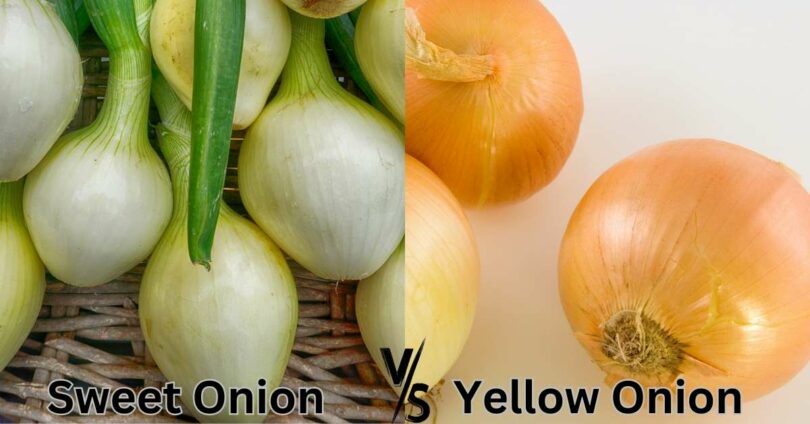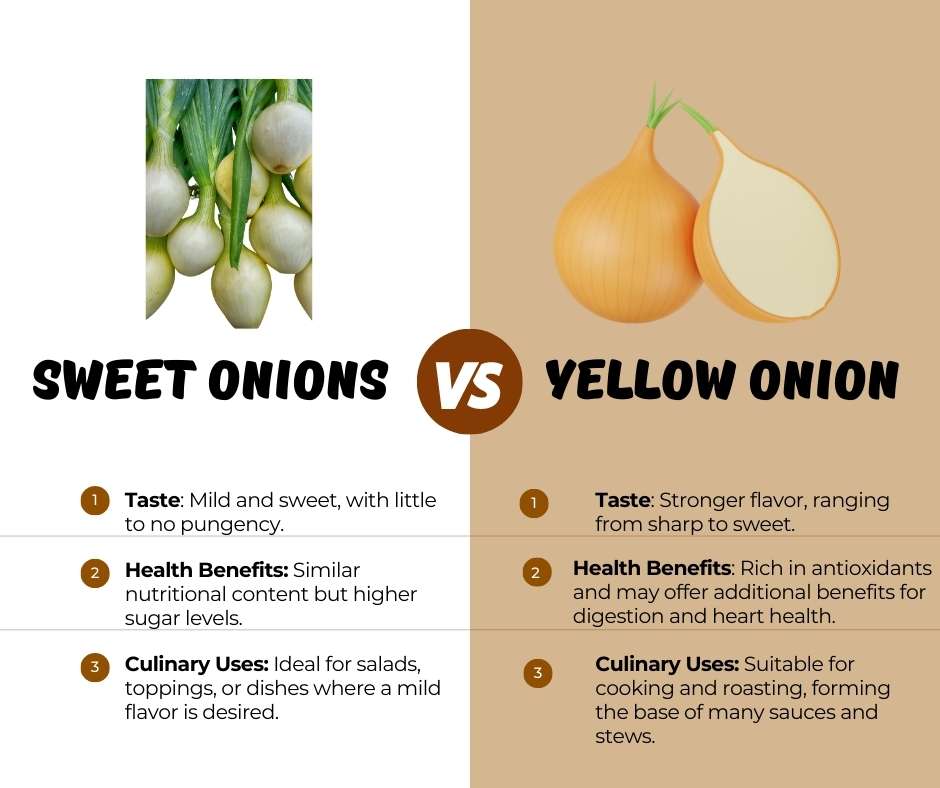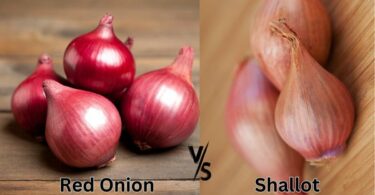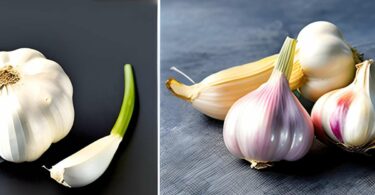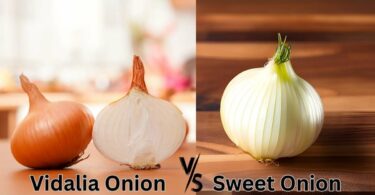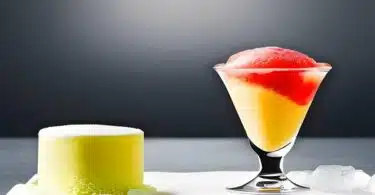The Battle of the Bulbs.. Onions, the tear-jerking staples in kitchens across the globe, are more than just a culinary essential. They’re the unsung heroes of countless recipes, adding depth and flavor to dishes. Among the diverse varieties, two types often cause confusion: sweet onions and yellow onions.
But when it comes to dicing these two kinds of onions, specific tools can make your life easier. The Breville Sous Chef 16 Pro or Peel and Dice is a splendid choice for those seeking precision in chopping and slicing. On the other hand, the Ninja BN600 or BN601 is known for its robust performance and versatility.
In this guide, we’ll unravel the differences between sweet and yellow onions, from taste to nutritional content. Whether you’re a professional chef or an amateur home cook, understanding these two types can elevate your culinary skills.
Peeling Back the Layers: What are Sweet Onions?
Taste and Texture
Sweet onions are a unique variety that offers a mild and pleasing sweetness. Unlike other onions that can be sharp or pungent, sweet onions have a higher sugar content and a lower sulfur content. This delicate balance allows them to be enjoyed raw in salads or lightly cooked to enhance their sweetness.
Culinary Uses
These onions are fantastic for caramelizing, as their natural sugars break down to create a rich, sweet flavor that can enhance many dishes. From topping burgers to blending into a smooth soup, sweet onions are highly versatile.
Health Benefits and Nutritional Content
Sweet onions aren’t just tasty; they’re nutritious too. Packed with Vitamin C, fiber, and antioxidants, they can be a wholesome addition to a balanced diet.
Digging into the Details: What are Yellow Onions?
Flavor Profile
Yellow onions, on the other hand, are the all-purpose warriors of the kitchen. With a robust flavor that can range from sharp to sweet, they’re a staple in countless recipes. When cooked, they turn a rich, golden color and contribute to the depth of flavor in dishes.
Common Uses in Cooking
These onions are a favorite for sautéing, frying, and roasting. Whether it’s a base for a savory sauce or a component in a hearty stew, yellow onions are often the go-to choice.
Nutritional Facts and Health Benefits
Yellow onions share many health benefits with sweet onions, including antioxidant properties and essential vitamins and minerals. Additionally, they might aid in digestion and support heart health.
The variations between sweet and yellow onions may seem subtle, but they can make a significant impact on the taste and texture of your culinary creations. By choosing the right type for each recipe, you unlock new dimensions of flavor.
Side by Side: Sweet vs Yellow Onions Comparison
Taste Test: A Flavorful Comparison
While both sweet and yellow onions have their place in the culinary world, their differences in flavor and texture are key to their applications in cooking. Sweet onions have a mild, gentle sweetness, often lacking the bite or astringency found in yellow onions. Conversely, yellow onions offer a rich, complex flavor that develops into a sweeter profile as they cook.
Cooking Techniques: How to Make the Most of Each Type
To enhance the natural characteristics of each onion, different cooking methods can be applied. Sweet onions, for example, can be grilled or caramelized to bring out their intrinsic sweetness. Yellow onions, on the other hand, benefit from longer cooking times, as in roasting or sautéing, to bring out their full-bodied flavor.
Which One to Choose? A Guide for Different Recipes
Choosing between sweet and yellow onions might depend on the recipe. A sweet onion might be perfect for a fresh summer salad, while a yellow onion would be ideal for a rich gravy or meaty stew.
Expert Tips and Tricks: Cooking with Sweet and Yellow Onions
Whether you’re an aspiring chef or a home cook, knowing how to handle onions is a skill that can elevate your dishes. From selecting the freshest bulbs to using the right chopping techniques, these insights will enhance your culinary journey.
- Selecting the Best: Look for firm, unblemished onions. Sweet onions should feel heavy for their size, while yellow onions should have a strong, aromatic scent.
- Storing Properly: Sweet onions tend to have a higher moisture content and should be stored at room temperature in a cool, dry place. Yellow onions are more forgiving and can be stored in a dark, cool pantry for several weeks.
- Chopping Like a Pro: Practice safe chopping methods and consider tools like the Breville Sous Chef 16 Pro or Peel and Dice for consistent results.
- Understanding the Impact: Experimenting with different types of onions in various recipes will help you appreciate the distinct qualities each one brings to the table.
Conclusion: Finding the Right Onion for Your Kitchen
The journey through the world of sweet and yellow onions reveals a spectrum of flavors, textures, and culinary applications that can transform ordinary dishes into extraordinary meals. Understanding these onions is more than just a culinary skill; it’s an art that can elevate your cooking and broaden your palate.
Sweet Onions: A Recap
Sweet onions are like the gentle melody in the symphony of flavors. With their mild sweetness, lack of pungency, and versatile nature, they can be used in a wide range of dishes. Whether it’s a crispy onion ring or a delightful salsa, sweet onions add a touch of grace and sophistication.
Yellow Onions: A Recap
Yellow onions are the robust backbone of countless culinary creations. Their strong flavor, adaptability to different cooking techniques, and ability to meld into the dish make them an indispensable ingredient in kitchens worldwide. From a hearty soup to a savory roast, yellow onions lend depth and complexity.
Choosing the Right Tools
Don’t forget that having the right tools, such as the Breville Sous Chef 16 Pro or Peel and Dice and the Ninja BN600 or BN601, can make the process of handling these onions even more enjoyable. Investing in quality kitchen gadgets can turn ordinary cooking into a delightful experience.
Final Thoughts
The choice between sweet and yellow onions doesn’t have to be a perplexing decision. Embrace the diversity and experiment with both types in your culinary adventures. By doing so, you’ll uncover the nuances that make each onion unique and learn to appreciate their individual contributions to the art of cooking.

